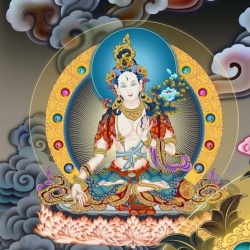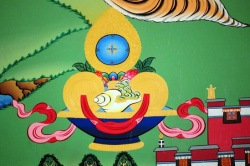Difference between revisions of "Eight practice lineages"
| Line 1: | Line 1: | ||
[[File:12c21 n.jpg|thumb|250px|]][[File:101vc41 n.jpg|thumb|250px|]] | [[File:12c21 n.jpg|thumb|250px|]][[File:101vc41 n.jpg|thumb|250px|]] | ||
| − | [[Eight Practice Lineages]] aka the [[Eight Great Chariots of the Practice Lineage]] (Wyl. '[['sgrub brgyud shing rta chen mo brgyad]]'') — the eight [[principal]] [[traditions]] which 'transported' the [[Buddhist teachings]] from [[India]] to [[Tibet]]. They are: | + | [[Eight Practice Lineages]] aka the [[Eight Great Chariots of the Practice Lineage]] ([[Wyl.]] '[['sgrub brgyud shing rta chen mo brgyad]]'') — the eight [[principal]] [[traditions]] which 'transported' the [[Buddhist teachings]] from [[India]] to [[Tibet]]. They are: |
| − | #[[Nyingma]]—the teachings of the [[kama]], [[terma]] and [[pure vision]] [[traditions]] within the [[Nyingma School]] of [[Ancient Translations]], which had come down in an aural [[lineage]] transmitted by countless learned and accomplished [[masters]], all thanks to the [[kindness]] of [[Khenpo]] [[Shantarakshita]], [[Guru]] [[Padmasambhava]] and the [[Dharma-King]] [[Trisong Deutsen]]. | + | #[[Nyingma]]—the teachings of the [[kama]], [[terma]] and [[pure vision]] [[traditions]] within the [[Nyingma School]] of [[Ancient Translations]], which had come down in an aural [[lineage]] transmitted by countless [[learned and accomplished]] [[masters]], all thanks to the [[kindness]] of [[Khenpo]] [[Shantarakshita]], [[Guru]] [[Padmasambhava]] and the [[Dharma-King]] [[Trisong Deutsen]]. |
#[[Kadam]]—the [[divine]] teachings of the Old and [[New Kadam]] [[traditions]], founded by the incomparable and glorious [[Lord]] [[Jowo Atisha]] and further developed through the magnificent efforts of [[Lobsang Drakpa]], who was [[Manjushri]] in [[person]]. | #[[Kadam]]—the [[divine]] teachings of the Old and [[New Kadam]] [[traditions]], founded by the incomparable and glorious [[Lord]] [[Jowo Atisha]] and further developed through the magnificent efforts of [[Lobsang Drakpa]], who was [[Manjushri]] in [[person]]. | ||
| − | #[[Lamdré]]/[[Sakya]]—the [[essential]] instructions of the '[[Path with its Result]]' (Tib. ''[[Lamdré]]''), the [[heart-essence]] of the [[mahasiddha]] [[Virupa]], which came down to the glorious [[Sakyapa]] founders and their heirs, and were then passed on by the various [[lineages]] including those of [[Sakya]], [[Ngor]] and [[Tsar]] (Wyl. ''[[sa ngor]] [[tsar gsum]]''). | + | #[[Lamdré]]/[[Sakya]]—the [[essential]] instructions of the '[[Path with its Result]]' (Tib. ''[[Lamdré]]''), the [[heart-essence]] of the [[mahasiddha]] [[Virupa]], which came down to the glorious [[Sakyapa]] founders and their heirs, and were then passed on by the various [[lineages]] including those of [[Sakya]], [[Ngor]] and [[Tsar]] ([[Wyl.]] ''[[sa ngor]] [[tsar gsum]]''). |
#[[Marpa Kagyü]]—the four streams of teachings within the [[Kagyü]] [[tradition]] that stems from [[Marpa]], [[Milarepa]] and [[Gampopa]], and branched into the four major and eight minor [[Kagyü]] [[lineages]]. | #[[Marpa Kagyü]]—the four streams of teachings within the [[Kagyü]] [[tradition]] that stems from [[Marpa]], [[Milarepa]] and [[Gampopa]], and branched into the four major and eight minor [[Kagyü]] [[lineages]]. | ||
| − | #[[Shangpa Kagyü]]—the golden [[doctrine]] of the [[dakini]] [[Niguma]] from the glorious [[Shangpa Kagyü]], which comes from the learned and accomplished [[Khyungpo Naljor]]. | + | #[[Shangpa Kagyü]]—the golden [[doctrine]] of the [[dakini]] [[Niguma]] from the glorious [[Shangpa Kagyü]], which comes from the [[learned and accomplished]] [[Khyungpo Naljor]]. |
| − | #[[Kalachakra]]/'[[Six Branch Practice of Vajrayoga]]' (Tib. ''[[Jordruk]]''; Wyl. ''[[sbyor drug]]'')—the '[[Six-Branched Application]]', which emphasizes the [[Vajra]] [[Yoga]] of the [[dzogrim|perfection stage]] of the splendid [[Kalachakra]], and which came to [[Tibet]] from the [[noble]] [[Dharma-kings]] of [[India]] and others such as [[Kalapada]] in early, [[intermediate]] and later phases, and developed into seventeen [[traditions]], which were then brought together and passed on by the renunciate [[Tukjé Tsöndru]] and others. | + | #[[Kalachakra]]/'[[Six Branch Practice of Vajrayoga]]' (Tib. ''[[Jordruk]]''; [[Wyl.]] ''[[sbyor drug]]'')—the '[[Six-Branched Application]]', which emphasizes the [[Vajra]] [[Yoga]] of the [[dzogrim|perfection stage]] of the splendid [[Kalachakra]], and which came to [[Tibet]] from the [[noble]] [[Dharma-kings]] of [[India]] and others such as [[Kalapada]] in early, [[intermediate]] and later phases, and developed into seventeen [[traditions]], which were then brought together and passed on by the renunciate [[Tukjé Tsöndru]] and others. |
#[[Shyijé]] and [[Chö]]—the [[noble]] teachings of the 'Pacifying of [[Suffering]]' [[Tradition]] coming from [[Padampa Sangyé]] together with the profound teachings on the [[objects]] of severance, or [[Chö]], which were passed on by [[Machik Lapdrön]] and others. | #[[Shyijé]] and [[Chö]]—the [[noble]] teachings of the 'Pacifying of [[Suffering]]' [[Tradition]] coming from [[Padampa Sangyé]] together with the profound teachings on the [[objects]] of severance, or [[Chö]], which were passed on by [[Machik Lapdrön]] and others. | ||
#'[[Approach and Accomplishment of the Three Vajras]]'—the teachings bestowed on the [[mahasiddha]] [[Orgyenpa Rinchen Pal]] by the mother of the [[buddhas]], [[Vajrayogini]] herself. | #'[[Approach and Accomplishment of the Three Vajras]]'—the teachings bestowed on the [[mahasiddha]] [[Orgyenpa Rinchen Pal]] by the mother of the [[buddhas]], [[Vajrayogini]] herself. | ||
| Line 17: | Line 17: | ||
==Further Reading== | ==Further Reading== | ||
| − | ===In Tibetan=== | + | ===In [[Tibetan]]=== |
{{Nolinking|*''sgrub brgyud shing rta chen mo brgyad kyi bsdus 'grel'', mi rigs dpe skrun khang, 1999}} | {{Nolinking|*''sgrub brgyud shing rta chen mo brgyad kyi bsdus 'grel'', mi rigs dpe skrun khang, 1999}} | ||
| Line 31: | Line 31: | ||
[[Category:Buddhist Practices]] | [[Category:Buddhist Practices]] | ||
[[Category:Tibetan Buddhism]]{{BuddhismbyNumber}} | [[Category:Tibetan Buddhism]]{{BuddhismbyNumber}} | ||
| + | [[Category:Lineage]] | ||
Latest revision as of 13:19, 24 November 2015
Eight Practice Lineages aka the Eight Great Chariots of the Practice Lineage (Wyl. ''sgrub brgyud shing rta chen mo brgyad) — the eight principal traditions which 'transported' the Buddhist teachings from India to Tibet. They are:
- Nyingma—the teachings of the kama, terma and pure vision traditions within the Nyingma School of Ancient Translations, which had come down in an aural lineage transmitted by countless learned and accomplished masters, all thanks to the kindness of Khenpo Shantarakshita, Guru Padmasambhava and the Dharma-King Trisong Deutsen.
- Kadam—the divine teachings of the Old and New Kadam traditions, founded by the incomparable and glorious Lord Jowo Atisha and further developed through the magnificent efforts of Lobsang Drakpa, who was Manjushri in person.
- Lamdré/Sakya—the essential instructions of the 'Path with its Result' (Tib. Lamdré), the heart-essence of the mahasiddha Virupa, which came down to the glorious Sakyapa founders and their heirs, and were then passed on by the various lineages including those of Sakya, Ngor and Tsar (Wyl. sa ngor tsar gsum).
- Marpa Kagyü—the four streams of teachings within the Kagyü tradition that stems from Marpa, Milarepa and Gampopa, and branched into the four major and eight minor Kagyü lineages.
- Shangpa Kagyü—the golden doctrine of the dakini Niguma from the glorious Shangpa Kagyü, which comes from the learned and accomplished Khyungpo Naljor.
- Kalachakra/'Six Branch Practice of Vajrayoga' (Tib. Jordruk; Wyl. sbyor drug)—the 'Six-Branched Application', which emphasizes the Vajra Yoga of the perfection stage of the splendid Kalachakra, and which came to Tibet from the noble Dharma-kings of India and others such as Kalapada in early, intermediate and later phases, and developed into seventeen traditions, which were then brought together and passed on by the renunciate Tukjé Tsöndru and others.
- Shyijé and Chö—the noble teachings of the 'Pacifying of Suffering' Tradition coming from Padampa Sangyé together with the profound teachings on the objects of severance, or Chö, which were passed on by Machik Lapdrön and others.
- 'Approach and Accomplishment of the Three Vajras'—the teachings bestowed on the mahasiddha Orgyenpa Rinchen Pal by the mother of the buddhas, Vajrayogini herself.
Note: the Jonang and Gelug schools are not part of this list because they formed within Tibet.
History
Although these eight practice lineages figure prominently in the literature of the Rimé movement, especially, for example, the Treasury of Precious Instructions of Jamgön Kongtrul, and Shechen Gyaltsab's history of the teachings, the list pre-dates the movement by about 200 years. The list may be derived from an earlier list of the most important figures in each lineage, the so-called 'eight great pillars of the practice lineage', first mentioned by the 16th century master Tertön Sherab Özer.
Further Reading
In Tibetan
- sgrub brgyud shing rta chen mo brgyad kyi bsdus 'grel, mi rigs dpe skrun khang, 1999
In English
- Jamgön Kongtrul Lodrö Tayé, The Treasury of Knowledge, Book Eight, Part Four: Esoteric Instructions, A Detailed Presentation of the Process of Meditation in Vajrayana, Snow Lion, 2007
- Matthew Kapstein, 'gDams-ngag: Tibetan Technologies of the Self' in Cabezón and Jackson, ed., Tibetan Literature: Studies in Genre, Snow Lion, 1996
- Ngawang Zangpo, Jamgon Kongtrul's Retreat Manual, Snow Lion, 1994
- Ringu Tulku, The Ri-me Philosophy of Jamgön Kongtrul the Great, Shambhala Publications, 2006

